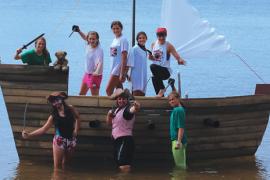Abstract: Improving public health and particularly addressing the rising childhood obesity epidemic are goals that camps can address. Obesity and overweight problems are a result of energy imbalances between eating and moving. Camps have a role to play in promoting and modeling healthy eating and enjoyable physical activity.
The health of young people has always been a concern in organized camp programs. The first camps began as efforts to get young people active in outdoor adventure experiences. Other camps such as the "fresh air" camps that emerged at the turn of the century had public health aims in getting children out of unhealthy industrial cities and into the countryside. The concerns for children's health, however, are somewhat different today. Values associated with camp do not generally include "improve public health" and yet the potential exists to address the health of young people at camps.
Childhood obesity is a major societal issue. Since the 1970s, the percentage of children aged six to eleven years who are obese has tripled. Further, obesity has doubled among adolescents. According to the Centers for Disease Control and Prevention, the percent of adults who are considered overweight or obese in the United States is 64 percent.
Further, the causes of these increases are clearly related to physical inactivity and unhealthy eating habits. Both of these issues can be addressed in camp programs.
A panel of experts convened by the Institute of Medicine identified five factors that discourage healthy eating and physical activity: frequent consumption of convenience foods in families due to the costs of food and time for preparation, reduced access to nutritious food such as fruits and vegetables, community designs that discourage walking and other forms of physical activity, decreased opportunities for physical education in schools and reduced walking and biking to schools because of their locations, and the amount of time children spend in sedentary screen time versus being active outdoors. Although going to camp will not address all these issues, camps can be more intentional in addressing physical health issues.
The TRU Study (Teenage Research Unlimited, Inc.) reported in recent issues of Camping Magazine has reviewed information about young people (aged twelve to nineteen years) who said they definitely would attend a summer camp in 2007 compared to youth who said they would definitely not attend. Some of the questions asked related directly to physical health. The responses may provide directions for camp staff who want to make sure campers eat healthy food and get adequate physical activity while they are at camp.
Nutrition Issues
The TRU study asked several questions about eating habits. One question related to the number of soft drinks consumed in the last seven days. The overall average was almost ten drinks. Young people who were coming to camp drank about two less drinks (i.e., eight) per week than the noncamp participants. The participants in the survey were also asked about the number of times they ate salty snacks in the past seven days. The average was about five and a half times with little difference between campers and noncampers. Further, the young people were asked about the number of candy bars eaten in the last seven days. The average was 3.6 bars with youth going to camp eating on average one more bar each week than the noncampers.
These results suggest that these eating habits were not much different for campers compared to other children. However, camp staff can think about what these statistics might mean in camp. Both children and adults tend to prefer sweet and fatty foods. On average they consume a good deal of these foods at home. Should camps cater to the habits of these young people, especially through products sold at the "canteen?" Or, is camp a place to offer alternatives? Some studies have shown that increasing the availability of healthful foods, particularly in schools, can be effective. The same thing could be true for camps. A summary of research presented in a publication called Designing to Reduce Childhood Obesity suggested that a 50 percent reduction in the price of low-fat foods in vending machines in secondary schools resulted in a huge increase in the proportion of low-fat snacks sold. Would the same happen at camp? In addition to the canteen, camp food service workers could prepare meals with lower fat and salt content and offer a variety of fruits and vegetables prepared in appealing ways. Foods with natural sugars might be offered instead of processed sugars.
Physical Activity Issues
Researchers have recommended guidelines for youth physical activity culminating in at least sixty minutes of physical activity on most days of the week. Many youth do not meet this recommendation (i.e., especially girls and ethnic minorities) and the Centers for Disease Control and Prevention further found that activity levels decline with age. Most camp staff probably believe that campers get this required amount when they are at camp, but we have little proof for this claim.
Increasing the physical activity in camps may require knowing more about campers' interests. The TRU Study asked several questions to young people about activity and sports participation. The results showed that the average teen in the study listened to CDs, Tapes, MP3, and other musical devices about ten hours each week, watched TV for nine and a half hours, used the Internet for eight hours, listened to the radio for seven hours, talked on a cell phone for five hours, played sports four hours each week, and worked out three hours a week. Large differences did not exist between campers and noncampers, but campers played sports for an hour more each week than noncampers. Another category was "working at a regular paid job" and almost twice as much time was spent by noncampers each week at a job than teens who planned to attend camp.
Favorite sports, sports participation, and competitive sport involvement were other areas related to physical activity that were explored in the TRU Study. Young people who said they planned to go to camp were more likely to participate in particular sports either recreationally or competitively (see Table 1). Very few differences existed regarding popular favorite sports, but several differences were evident related to recreational sports participation. Examples of sports participation equally done by campers and noncampers included football, bicycling, billiards, volleyball, fishing, dancing, weight training, skateboarding, paintball, and golf although overall campers were slightly more likely to participate in all these activities.
One of the reasons that individuals gave for choosing to come to camp was "to do activities at camp that you can't do at home." Males (44 percent) were more likely to suggest they came for that reason than females (33 percent). The activities that they could not do at home were not necessarily physical activity, but these statistics coupled with the sports data raise questions about what activities should be promoted at camp that might differ from activities done at home. Similarly, based on the findings that youth who attend camp are more involved in sports (except for soccer) raises further questions about the potential for camp to introduce new opportunities for youth who are already engaged and active.
Implications
Camps are not automatically healthy places for young people. Although the American Camp Association (ACA) Accreditation Standards address many issues regarding risk management to ensure the health and safety of campers, they do not address issues related to energy balance associated with physical activity and nutrition. Helping young people to learn the joys of eating nutritiously and being physically active are important outcomes that can be addressed at camp. Although one week at camp may not change a person's life forever, one week of modeling good eating habits and enjoyable physical activity will do no harm and may stimulate some continued interest.
Several broad suggestions emerge from these TRU Study data along with other information that is known about camp.
- Many young people are not accustomed to eating healthy meals that are lower in fat and sugars. Recognizing that alternatives exist when choosing snacks as well as having good tasting nutritious food may be a contribution that camps can make.
- Most young people (and adults as well) participate in physical activity because it is enjoyable. Most children do not participate in various activities because they are "good for them." The challenge to camp staff is to not make "exercise" onerous but to make it fun. Assuring that the focus is not on fitness but on participation is likely to have more appeal to most campers.
- Although all young people need enjoyable opportunities to be involved in a variety of physically active alternatives at camp, girls in particular tend to participate less as they get older for various reasons (i.e., lack of interest, lack the skills, body selfconsciousness, societal expectations of femininity). Camp can be an opportunity to introduce girls to new activities in a safe environment that enable them to develop confidence in their skills so they might find enjoyable opportunities when they return home.
- Some of the activities young people do at camp can become life-long endeavors. Planning activities that have the potential for developing long-term skills (e.g., camping, hiking) may be experiences that young people will not have at home.
The obesity epidemic in children must be addressed in many ways. More children are growing up with fewer opportunities to learn healthy eating behaviors and are living in neighborhoods that lack places (especially outdoor areas) to be physically engaged in fun activities. Camp may be a place where children can be challenged to pay attention to their eating and activity levels while providing them with role models and a positive environment that supports healthy living. The imperative to promote a healthy lifestyle in young people is critical. Camp staff can exert some influence now or deal with the repercussions later when these youth become obese, chronically ill adults with an "illness" rather than wellness approach to life.
Karla A. Henderson, Ph.D., is a professor at North Carolina State University and a member of the American Camp Association's (ACA's) Committee for the Advancement of Research and Evaluation (CARE).
M. Deborah Bialeschki, Ph.D., is senior researcher with ACA.
Originally published in the 2008 September/October issue of Camping Magazine.


